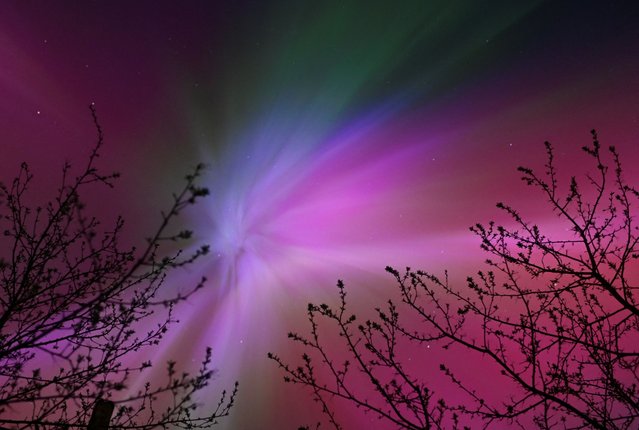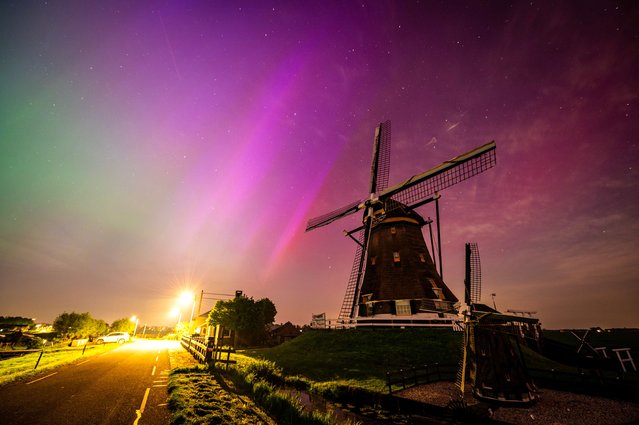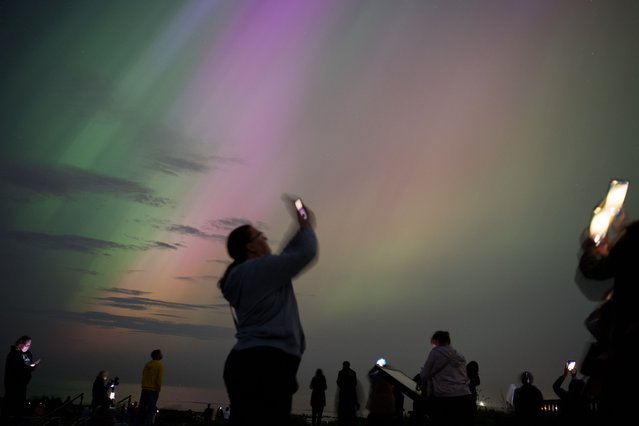
Old tombstones stand against the northern lights at a cemetery early Saturday, May 11, 2024, near Skidmore, Mo. (Photo by Charlie Riedel/AP Photo)

The northern lights flare in the sky over a farmhouse, late Friday, May 10, 2024, in Brunswick, Maine. (Photo by Robert F. Bukaty/AP Photo)

The Northern Lights as seen from the Stormville Mountain rest stop on Interstate 84 in East Fishkill, NY, early Saturday morning, May 11, 2024. (Photo by Frank Becerra Jr./The Journal News via USA TODAY Network)

A photographer's camera setup is seen as the Aurora Australis, also known as the Southern Lights, glow on the horizon over waters of Lake Ellesmere on the outskirts of Christchurch on May 11, 2024. The most powerful solar storm in more than two decades struck Earth, triggering spectacular celestial light shows from Tasmania to Britain – and threatening possible disruptions to satellites and power grids as it persists into the weekend. (Photo by Sanka Vidanagama/AFP Photo)

Northern lights or aurora borealis illuminate the night sky over Fusch an der Großglocknerstraße, near Zell am See, during a geomagnetic storm on May 11, 2024. The planet is experiencing its first “extreme” geomagnetic storm since 2003, a US agency said on Mai 10, 2024. (Photo by JFK/APA via AFP Photo)

People pose for a photograph with the Aurora Borealis, also known as the Northern Lights, in Crosby, Britain, 10 May 2024. The National Oceanic and Atmospheric Administration (NOAA) of America has warned that the strongest geomagnetic storm for 20 years is set to hit Earth, making the Aurora Borealis, or Northern Lights, visible at much lower geomagnetic latitudes than usual. (Photo by Adam Vaughan/EPA/EFE/Rex Features/Shutterstock)

The Aurora Borealis, known as the Northern Lights, is visible behind Anthony Gormley's “Another Place” sculpture in Crosby, Britain, 10 May 2024. (Photo by Adam Vaughan/EPA/EFE/Rex Features/Shutterstock)

A view shows the lights of an aurora australis caused by a geomagnetic storm, in Punta Carrera, Chile on May 10, 2024. (Photo by Joel Estay/Reuters)

An aurora borealis is seen above Lausanne and the Jura from the Tour de Gourze in Riex, Switzerland, on May 11, 2024. (Photo by Denis Balibouse/Reuters)

The aurora borealis, also known as the 'northern lights’, are seen over The Roaches near Leek, Staffordshire, Britain, on May 10, 2024. (Photo by Carl Recine/Reuters)

The aurora borealis, also known as the 'northern lights’, caused by a coronal mass ejection on the Sun, illuminate the skies over the southwestern Siberian town of Tara, Omsk region, Russia on May 11, 2024. (Photo by Alexey Malgavko/Reuters)

The Northern lights (aurora borealis) lights up the night sky above the Molenviergang in Aarlanderveen, the Netherlands, early on 11 May 2024. The National Oceanic and Atmospheric Administration (NOAA) of America has warned that the strongest geomagnetic storm for 20 years is set to hit Earth, making the Aurora Borealis, or Northern Lights, visible at much lower geomagnetic latitudes than usual. (Photo by Josh Walet/EPA/EFE/Rex Features/Shutterstock)

People visit St Mary's lighthouse in Whitley Bay to see the aurora borealis, commonly known as the northern lights, on May 10, 2024 in Whitley Bay, England. The UK met office said a strong solar storm may allow northern parts of the UK the chance to see displays of aurora. (Photo by Ian Forsyth/Getty Images)

A view shows the lights of an aurora australis caused by a geomagnetic storm, in Punta Carrera, Chile on May 10, 2024. (Photo by Joel Estay/Reuters)

A car drives on the road and illuminates poplars under the Northern lights (aurora borealis) glow in the night sky above the village of Daillens, Switzerland, 11 May 2024. The National Oceanic and Atmospheric Administration (NOAA) of America has warned that the strongest geomagnetic storm for 20 years is set to hit Earth, making the Aurora Borealis, or Northern Lights, visible at much lower geomagnetic latitudes than usual. (Photo by Laurent Gillieron/EPA/EFE/Rex Features/Shutterstock)
17 Aug 2024 04:31:00,
post received
0 comments
